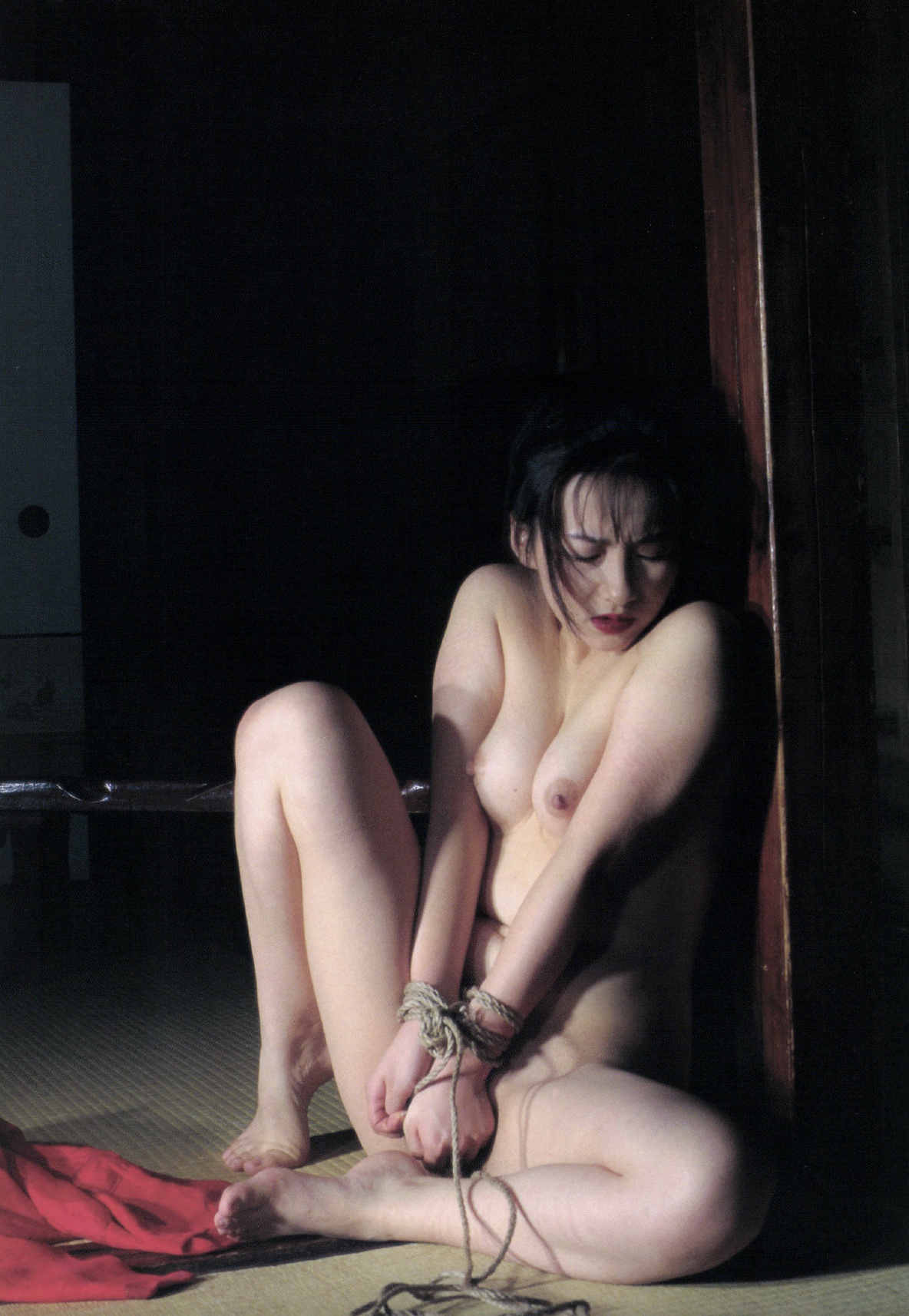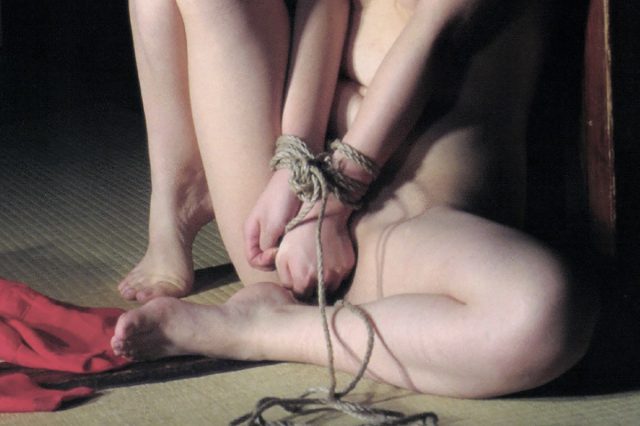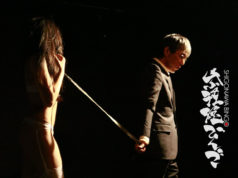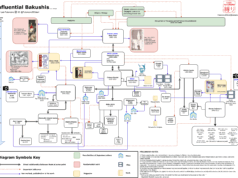KINBAKU TODAY CHRISTMAS DEBATE
This is the final part of the virtual discussion between Ugo san of SMpedia, Marc BeShibari and Sin. I’d like to express my deepest appreciation and sincere thanks for their allowing me to facilitate what has proven to be a very lively debate.
Any method of learning is valid, and Dojō/workshops have their place. Some particularly enjoy technical aspects, and others need the structures offered as a basic foundation. If one can make a living teaching this way, I’m in full support.
However, I don’t believe one person can own a style as rope bondage is, as you all state, continually evolving. Those involved with rope are inspired by others, emulating techniques and personalizing them. The unknowns of what rope bondage will look like in the next era is exciting, especially if individuals continue to learn outside the boundaries of these systems, and allow their idiosyncratic ways to blossom.
But what about the person being tied? How will this evolution impact them?
Ugo: I began talking to western enthusiasts around 2009. We exchanged ideas and I learned a lot of new things. One that surprised me was there may not be an equivalent in the West to the emotion of our Hazukashii. I suspect that like Seme, it doesn’t have a word that fits perfectly in English. Sin–san told me that, in this case, ‘abashed’ might be closest. Hazukashii is also sometimes translated as ‘shamed’ or ‘disgraceful’. I think it’s a difficult sensation to define if westerners don’t have it. It’s a feeling that creates a paradoxical state of mind, consciously or subconsciously, with an erotic pleasure, and a guilt about doing something ‘wrong’.
When I first heard the West doesn’t have this sense it was hard to believe, because the sensation is so common for us. However, considering that differences in tastes may exist between ethnic and cultural backgrounds, it’s perhaps not surprising Hazukashii is characteristic of a particular group. I don’t know if it’s a good example, but in the Victorian era a positive value was placed on young women who blushed. Over time, this gave way to a negative value, and the number of women who blush has decreased. This suggests the sense is more cultural, and supported by one westerner who told me, “It seems that in my grandmother’s time there was such a sense”. Human senses evolve with time. The sense of Hazukashii that once existed in the West may now have largely disappeared.
The evolution of emancipation and gender equality must have changed us. I believe the sense of Hazukashii Japanese had in the Shōwa–era will disappear. What annoys me is my favourite SM is largely dependent on this sense. In the aesthetic philosophy of Minomura, Dan Oniroku, Nureki and Yukimura, this feeling was very important. Recently, I feel it’s gradually diminishing among young people in Japan. Cultural change will evolve our minds, and consequently, the nature of SM will change. In this sense, my type of SM is slowly dying out.
This theory of the extinction of Hazukashii is based on information from a small number of friends. And, unfortunately, my experiences of Kinbaku play with non–Japanese is very limited. Furthermore, each country in the West must have differing cultures. Therefore, I may misunderstand about local feelings of abashment. In this regard, I’d be very happy to hear the opinions of Sin–san, who has a lot of experience playing with Japanese ladies, and Marc–san, who works in a multicultural region of Europe.
Another example of how cultural evolution affects SM is how, following Nureki and Akechi, Yukimura came into the scene in the 1990s. In my opinion, Nureki’s Kinbaku was best in photographs. Contrastingly, the next generation, Akechi was famed for live performance, establishing a dynamic world of Kinbaku that evolved over time. Yukimura was of the following generation. Since he was essentially an AV director, he was also in a position to develop Kinbaku play over time. In his case, he explicitly considered it should be developed from a circular interaction between him and the woman (in his case) being tied, i.e. play develops from the mutual communication in real time between the one tying and the one being tied. The one tying receives instant non–verbal messages from the one being tied and almost simultaneously feeds back the next message. These interacting cycles are repeated and generate the dynamic development of play.
Advocates of Nureki and Akechi may argue, saying both had already established this in their play. It may be true, but Yukimura was explicitly focused on this element, and established his own philosophy based upon it. Here, we notice the one being tied is not a passive participant, but active in the play. I think this characterizes the person being tied in the era of inclusion.
In the example of the photography of Araki Nobuyoshi in the 90s, we note the one to be photographed was not merely the passive model, but rather the one sending strong messages to Araki. He established a new relationship with the one being photographed, trying to capture the messages exchanged from behind the camera and the model.
Yukimura and Araki were among the main contributors to S&M Sniper, the most recent generation of SM magazine (Araki continued throughout its run). They were attacked by people who loved the older magazines (SM Select, SM Fan, SM Collector) who said, “Oh, this is not real SM!” because they were the next generation of it.
I became aware Kinbaku was booming in the West with the publication of Master K’s The Beauty of Kinbaku in 2008 and The London Festival of the Art of Japanese Rope Bondage in 2009. Since then, I have been following websites of western Kinbaku lovers. I’ve often seen the forced association of Kinbaku with traditions such as the tea ceremony, calligraphy and Budō, and thought it was nothing more than Orientalist misappropriation. Kinbaku in Japan developed without any connection to these traditions. But on reflection, when I look at the Kinbaku of those who are called ‘masters’, I have to admit their ways of tying is associated with so–called ‘Ma’ or ‘Ki’, which also gains recognition in traditional Japanese culture. By taking this view, people in the West may have reached deeper insights on Kinbaku, and may establish the next generation earlier than the Japanese.
At any rate, Japanese Kinbaku has entered into a new environment in the West, and can evolve by adapting to western culture. There may be some confusion for a while, but I believe we can see the birth of this new western–style Kinbaku in the near future. After discussing with you, I really start to believe you’re making a new style that fits current culture.
Marc: Ugo notes the very interesting concept of Hazukashii: “a feeling that creates a paradoxical state of mind, consciously or subconsciously, with an erotic pleasure, and a guilt about doing something ‘wrong’.” We see this in pictures and performances from Japan. However, in tying western ladies I’ve experienced different attitudes towards shame or abashment, ranging from total shamelessness to deep feelings of guilt.
This is where Europeans differ from the Japanese: a sense of being shamed in Kinbaku will produce an eroticizing effect in the Japanese model, but in Europe even today, many find it very difficult to freely enjoy the things that also make them feel ashamed. I’m not an expert on European culture, but a little background can help clarify these differences. Since the early Middle Ages our culture has generally been shaped by Christianity. The concept of guilt and retribution was firmly rooted and it still echoes in modern European societies. For many the amount of guilt still may surpass the erotic feelings they have, whereas more sexually liberated spirits don’t seem to feel any shame at all.
As sexual revolution(s) in Europe opened people’s minds, Western women underwent a profound sexual liberation. They now often accentuate or show their bodies, no longer appearing ashamed. In my own practice I’ve more than once been confronted by girls at a first session entering, casually taking off their clothes and asking, “Okay, what do you want to do?” Such attitudes don’t invite you to play with shame.
In Japan and perhaps the Orient in general, when a lady wants to be tied, there’s an enticing sense of ‘I want you to discover the real me’. You’re tempted to discover what and who is under the clothing. You’re embarking on an adventure when tying a woman in a Kimono or a Sari – long and elaborate garments carefully protecting the model’s body, inviting you to undertake a sensual journey with her before you can so much as bare a breast.
In Europe we see people using Kimonos in their play. The model reacts in a way remotely reminiscent of how a Japanese woman would react to the Kimono being opened at the shoulders or legs. However, this reaction does not feel genuine to me, for there’s no actual sense of Hazukashii. It seems a premeditated response, as if the model is expected to react this way.
As Shibarite, I believe you need to approach a session with a model of a different cultural background from another angle and communicate and interact in a different way. I found there’s a huge difference between tying with women from the Orient or from the West. When tying with European models, I’ve developed my own rhythm and ‘vibe’ and it works for both of us. But when I took the same personal energy to a session with a Japanese lady, I suddenly found I’d entered a totally different arena and had to rigorously adapt. The same happened in sessions with Indian ladies. Not only are Asian ladies’ bodies different proportions than those of Europeans, but also their emotional responses aren’t the same. It was a bit like going out for dinner in India or Japan and all those questions that pop up: Do they eat with a knife and fork here? Where do I keep my chopsticks? How do I eat this bowl of noodles without making a fool of myself? When do I start eating? In short: which etiquette rules apply? You need to take note of all these little things prior to going to the restaurant to make sure you have a nice dinner. Stubbornly following your own ways will not lead to an agreeable experience for anyone. The same goes for an intercultural rope bondage session: you need to take into account each other’s cultural background before starting tying.
In my opinion, the modern western attitude towards shame and the erotic has paved the road to a different approach to Shibari, searching to sculpt the human body by applying rope and to bring to the surface a deeper layer of the personality through suffering. From a gradual sensual exposure, the experience has shifted to touching the soul and uncovering hidden emotions, even reaching into a more spiritual level.
Before I came out as a rope bondage and SM lover, I practiced as a Reiki therapist. In those sessions, clients often reached a deep level of inner peace. Others experienced strong and long–suppressed emotions. When doing Shibari, I realize the people I tie often have similar experiences, but now through suffering. We see more people searching for this inward journey, and Shibari appears to be one way to evoke it. We pull the focus away from the mind and into the body and the senses, so the person tied can let go of their thoughts. By playing with time, space and distance the receiver slowly enters a state of altered awareness. Shibari can bring suppressed emotions to the foreground and bring the receiver to emotional release, but I think it’s too far–fetched to call it a healing practice.
Today, models have a say in what’s going to happen and take initiatives to interact more than before. They often enter a session with specific expectations and express their own wishes and needs. In earlier times a woman seemed to enter a session with a mindset somewhat more service–minded to the aims of the person tying her.
Models have been given a greater responsibility for what will happen during a session. They need to be aware of what they can and cannot do, what they will and will not undergo within the boundaries of their minds and bodies, and they’re expected to communicate this to their top. We also see many models who’d like to learn to tie, as they want to know what it’s like from both perspectives. The consequence of these developments is that models keep better track of what Shibarists do with them. This makes them stay alert longer during a session and sometimes it takes some effort to shift their attention to their senses, make them let go and reach their emotional core.
Recent developments have contributed to more consensual and safer Shibari practices, but may lead to over–regulation, standardization and create an overprotective community that will eventually ostracize people who do not play according to its rules. I note this also evokes feelings of insecurity in contemporary Shibarists looking for approval, which leads to a decline in creativity, improvisation and a personal touch.
Pain as pleasure and erotic play gave us the thrill to start tying people: a kinky game played on the edge. The question for the future is: from the hot and kinky perversion, will Japanese inspired rope bondage cool down to lukewarm? Will we move further towards over–regulation of the scene? Or will the pendulum swing back to where there’s again room for intuition, the untamed and the unexpected?
Being a pioneer, tying intuitively, the overall cleaner style of rope bondage practiced in the West today isn’t very exhilarating to me. To newer generations it seems to be exactly what they like. My personal tastes aside, I strongly believe we are on the edge of a new era in Japanese bondage where there’s room for all these different directions. That is the aim with which my partner Jess and I started Shibari Lounge, to provide a platform for local and international Shibarists to enjoy the entire spectrum of Japanese inspired rope bondage.
Sin: I’ve found the debate incredibly insightful, and we clearly see how the past era of inclusion has altered views on rope bondage. The sheer numbers of participants have led to an incredible variety in objectives. This is to be expected. With growth comes potential for better understanding, learning and acceptance of diversity.
Apart from malignant ambition, of concern are sophomoric attempts to define ‘original’, ‘traditional’, etc. and, individual intimacy being discounted for manipulated uniformity to fit someone else’s concept of a ‘True–Way’. Naively falling for lineages and certificates is, I believe, detrimental to evolve beyond the elemental. It hasn’t been helpful to mythicize Pornographers into Grandmasters, etc. where we should be honest, rather than glossing over facts, or inventing new ones, for whatever purpose. We should view desires to be ‘Deshi’ and associated assertions without recorded proclamation by benefactors with justified mistrust, and recognize, in context, how it just means student, or follower. For if it were to be translated as adherent, said student, or follower could not declare their own style.
But most frightening are newcomers following an all–too–common route: the image of an attractive body suspended piques interest, and they think, ‘I want to do that!’ Armed with a certain gullibility, they quickly consume material, attend lessons, and rush past profound reason toward this goal. The moment they believe they’re competent, they want to become a leader, a celebrity, get the pick of the herd, teach others, where they’ve essentially missed the objective. Thus, entitlement is a monster of our own creation. We feel we instantly deserve something without too much effort, or painstaking engagement over time.
Integrity and authenticity are phenomenally important when interacting with others at this level, for our partners are armed with intuition. Emotional intelligence, even if latent within us takes years, decades of maturity to develop. One can’t take a lesson with a Japanese, or spend a week in Tokyo and think we understand. Learning from educators several stages removed has greater hazards of dilution perpetuating bad practice. As Ugo rightly says, “Japanese culture tends to give importance to mastering repeated simple exercises prior to acting intuitively.” Tutors racing students to suspensions is utterly contradictive. Occasionally, I hear people proudly proclaim such inane statements as, ‘I follow so–and–so’s style’ and I’m always left thinking, ‘You’ll grow out of it’. The absurdities of attempting to fit this thing into a box, and worse, somebody else’s box, is troubling.
Back when I ‘came out’ from my secretive pleasures in Japan, I found people talking endlessly about ‘Japanese Bondage’. But I couldn’t identify anything in the Western scene that I’d encountered there, and sadly, I still see precious little correlation today. Japanese Bondage is a notion that only seems to exist abroad, yet enterprising nationals are now prepared to exploit it, servicing demand. We westerners view what the Japanese have done with their rope bondage through rose–tinted spectacles. As Marc points out, we crave the esoteric, the spiritual, the aesthetic, etc. without the underlying elements we fail to understand, or perhaps might feel repelled by, if we were to know their depths.
Ugo san’s example of Hazukashii is perfect. A difficult thing to find in the West, although not impossible. Those posting explicit images of themselves have little hope of inducing such delicacy for obvious reasons. We see riggers grunting and bunnies moaning at all the right moments, acting out the charade, implausible, and we know it’s wholly insincere. There appears a general lack of sophistication and finesse. With the Japanese being four decades ahead of us in exposing their Kinbaku to the mainstream, they’ve had time to cultivate dynamics far beyond the rope itself. It would be a shame for current contemporary attitudes to ignore, discount, and by doing so, eventually erase them.
Tempered by a variety of influences, I adore continual discovery and, deeply sado–erotic and psychologically–emotionally driven rope play. I enjoy developing fresh techniques, like memory narrative, sensory perception, rapid conditioning, etc. I love the challenges and adventure tying many, and particularly unknown, new ladies, spontaneously, unplanned, with a singular goal of them longing for more. I never think what I will tie, and I’ve forgotten what I’ve done immediately after, because the tying is peripheral. Not the aim of the exercise. I respect this is not for everyone, but I believe if Nureki, Akechi, and especially Yukimura could see what I do, they would approve, because I sense that they could relate.
Among others, I established a kinship with Ero Ouji, so I’m glad Ugo mentioned his skills – an amateur by choice, but way advanced of professionals currently adulated in the West. We established a circular inspiration, absorbing ideas, especially in private play together. There are so many influences from hidden characters behind the celebrities. While shunning the limelight, look at how Matsui Kenji radically changed Akechi’s tying in the mid–90s. I freely admit to absorbing ideas from anywhere. But what I am not, is just another conformist wanting to do things like somebody else. I seek to forge ahead on my own particular path, and not hang on the coat tails of others.
Regarding the influence of the Internet and Social Media: Artificial Intelligence, even in our field of reference is deeply insidious. We fall into its trap, and become component parts of its problem. Look at how politics has become insanely polemic during a pandemic where we should be pulling together for the common good. AI isn’t fantastical movies of robots hunting humans, but algorithms designed to collate data and maximize profits. An article grabs our attention, and unsolicited links lead us down a rabbit hole of indoctrination. We consume limited information, and our opinion fixes partisan, until disagreement becomes the polar opposite. Power weakens education, and we become farmed: creating consumption for unnecessary trinkets and status. Marketing is not for our benefit. Hyperbole; Truth Decay distorts our assessment of facts. We swallow unverifiable evidence, until the weight of voices denounces validity, and manipulates the mindset, affecting perception, including towards rope bondage.
There’s ongoing political deliberation regarding victims who’ve died through choking in SM play, and it only takes so many incidents before lawmakers pass legislation against our practices – another swing of the ‘pendulum’ Marc refers to. In some societies, unregulated capitalism has led to ‘Slavery-Lite’ where corporate employees are vetted and tested. What happens when an image of your half–naked, suspended body may determine you earning a living, or not? We’re in an age of enlightenment, and I sincerely hope it continues. But nothing is constant, as Ugo notes in the continual sanitization of SM.
I’ve been trying to identify what I sense is something largely missing within the community. Maybe it’s not national at all, but generational. I see the modern world producing differences far greater than between Japanese and westerners of my generation. If one looks at their younger age groups, the fading of Hazukashii is a clear indicator. It’s like the Kardashian woman, a celebrity for being nothing more than a celebrity, or Swarovski, shiny pieces of cheap cut glass imitating treasure. The world has become dazzled by the superficial, the mediocre, and doesn’t seem to grasp what’s exceptional, original, tangible anymore. We nourish on Social Media ‘Likes’ and ‘Followers’ from remote contacts, rather than focusing our attentions towards the ones we touch.
On a positive note, I sense the balance tilting back towards a new era of greater enlightenment. I hear the growing wave of emboldened practitioners recognizing that blindly cloning other’s technical ways isn’t healthy for free–spirits with capabilities for far more. We should come to better understanding our individual needs, both top and bottom, and move on from the ill–advised dogma–franchise cults, who will ultimately wane in influence.
Credible educators capable of conveyance will rise naturally to the surface, coaching mutual enjoyment – a more challenging, deeper route, but also more rewarding. This won’t rely on credo, or embellishment, but on solid realism. Empire builders who’ve attempted to establish fortunes on soft ground will be seen for what they are, and we can progress toward a healthier methodology of imparting information, uncorrupted by vested interests for those who may only grasp the tying, to those who seek more advanced facets.
What we do then becomes irrelevant to unseen onlookers. We don’t feel we have to show off, or competitively elbow others out of the way, and progress onwards to develop within our own idiosyncratic play. We will evolve to understand and provide for what our tying partners desire. And for those that can inspire at this level, the discerning will always identify authenticity, and be enthused by it. The original will go on to create their own individual approaches, and be inspirational to others in return. Those merely copying will either remain stranded, or ultimately make their own breakthroughs.
To paraphrase the Osaka Alcatraz Circle’s purpose from two decades ago, “There are various approaches. Some of them may be different from yours. If there are 100 people, there should be 100 approaches.” 100 individuals, 100 Ryū.

.







